Ah, the beach! A perfect spot for fun and relaxation. But going to the beach as a parent is a completely different experience than it was in those pre-child days. The days of bringing just a towel, sunscreen, and a book are over. While going to the beach with kids is definitely more work, it can also make for some of the best memories. As parents, we need to ensure our little beach bums stay safe and sound. No worries! Today, California mom Wendy Cox is here with some awesome beach safety tips that will make your family vacation a blast and worry-free. Follow these beach safety tips for parents and enjoy your seaside day.

Research your beach
Before your beach day, start by doing a little detective work to find the perfect spot for your family adventure. Consider beaches that offer a kid-friendly environment with amenities that cater to families. Check if the beach has lifeguards on duty. Having trained professionals watching over the water can provide peace of mind. Seek out beaches that offer convenient amenities for families with children: restrooms, showers, changing facilities, picnic areas, playgrounds, parks, etc.
Also, consider the beach’s popularity and its typical crowd size. Is the beach usually crowded or more secluded? Will there be other kids there for your kids to play with? Or would you rather have more space to spread out?
Look for amenities that enhance your family’s comfort and convenience, such as rental chairs or beach umbrellas. Is there easy access to parking? How far is the parking lot from the beach? Are there nearby shops or restaurants for grabbing snacks, ice cream, or refreshing drinks?
Don’t forget to check out reviews and recommendations from other families who have visited the beach. Online travel forums, family-oriented websites, or social media groups can provide valuable insights and firsthand experiences. Pay attention to positive feedback about cleanliness, safety, and the overall family-friendliness of the beach.
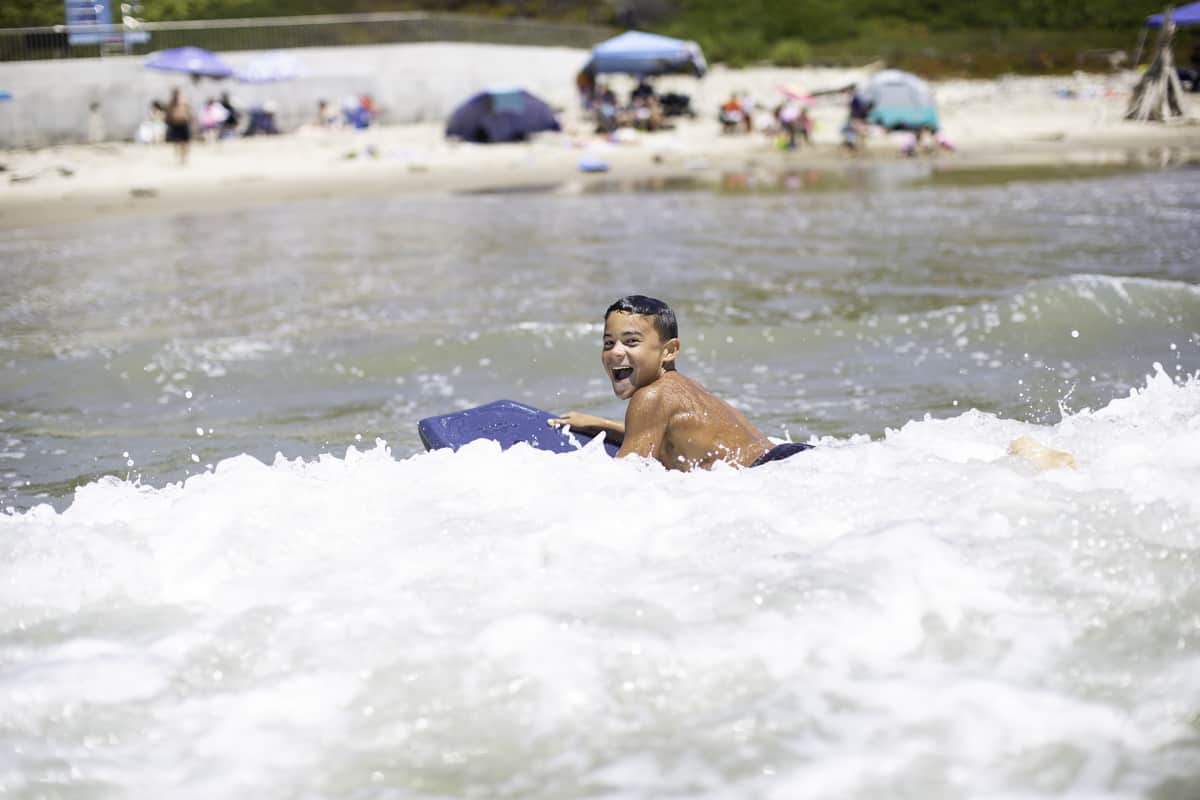
Arrive at the beach early
I’ve spent 13 summers at the beaches of Southern California, and to say beaches can get crowded is an understatement. It seems like the whole world is at the beach in the summer. Where we go, the parking situation is crazy, so I always attempt to get to the beach by 9 in the morning from June through August. It’s much easier to find a close parking spot during those morning hours. Because my husband is usually at work, I take all four of my kids by myself. That close parking spot makes all the difference when you have an arm (or wagon) full of towels, chairs, snacks, boogie boards, skim boards, sunscreen, umbrellas, sand toys, and the list could go on.
Another reason I like to get to the beach early is so that you can stake a claim on your space. There are fewer people at the beach in the morning, so you will have enough room to lay out all of your towels and toys and not feel like you’re crowding someone else. I like to be fairly close to the shore so I can still see my kids in the water without leaving my chair. I call that thinking smarter, not harder.
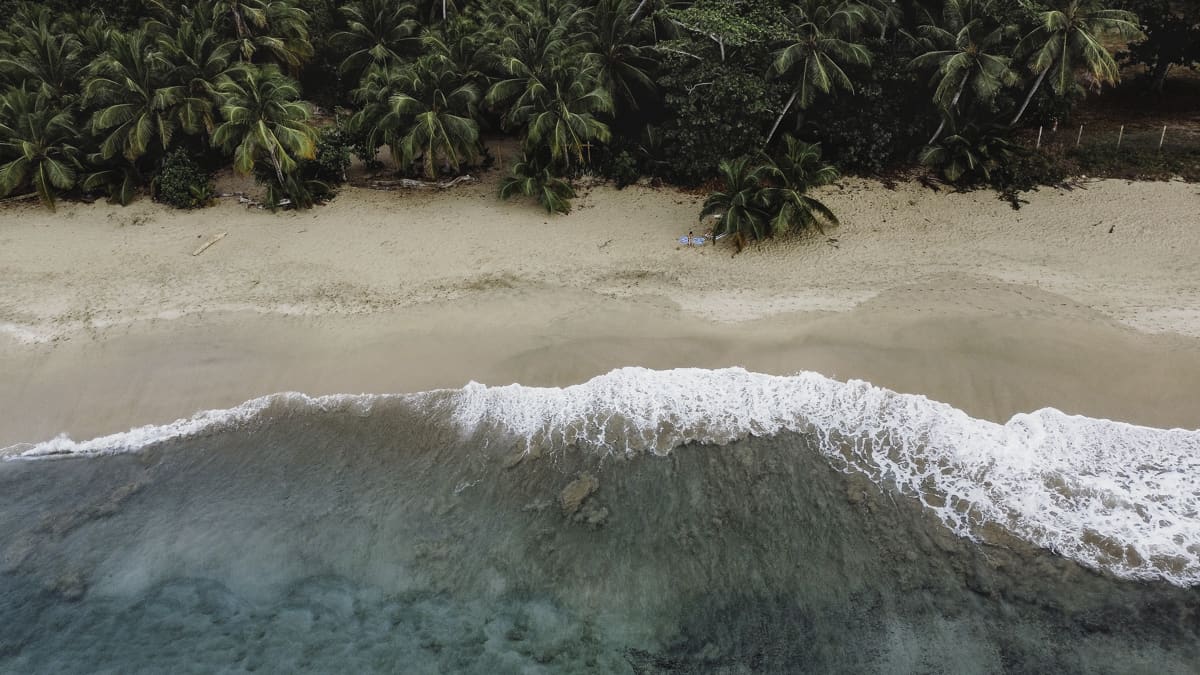
Water, water, water!
Chances are, if you’re spending a day at the beach, it’s a warm, sunny day. And spending all day building sandcastles can be thirsty and hungry work. It might mean a few extra pounds to carry or pull in the wagon, but you’ll want to bring lots of water! Your kids are going to get thirsty, and you’ll get thirsty. Pack a cooler filled with refreshing water and yummy, healthy snacks like juicy fruits (extra hydration) and energy bars. Remind the kiddos to take sips, even if they don’t feel parched.
I also bring extra water in case we need to rinse anything off without it getting salty. I’ve been guilty of not bringing enough water, and we’ve had to cut some beach days short because we ran out of water. The fussiness that ensued was more than I could bear, so we left. Don’t let that happen to you!
Take a photo and make a plan if you get separated
You surely have thousands of pictures of your kids on your phone, but when you get to the beach, snap a quick photo of your kids in their swimsuits so you know what they’re wearing. This is a safety precaution that will be extremely helpful if you have a child that wanders off or gets lost. You will have something to easily refer back to the photo, just in case.
It’s also a good idea to talk to your kids about how they can find you. Maybe you have a rainbow-colored umbrella, or a blue shade tent, or a yellow beach chair. Talk about these items so your kids know what to look for if they go refill a bucket with ocean water and need to make their way back.
And speaking of having a photo on your phone, I also recommend bringing a bag or sleeve to carry your phone in. Even a simple plastic sandwich bag works great to keep the sand out of your phone when it’s in a bag or the cup holder of your beach chair.

Stay near a lifeguard
I recently spoke with two local lifeguards and asked them for their best beach safety tips. Both lifeguards said that parents should stay near a lifeguard tower. This is especially true if you aren’t familiar with the beach or if your kids aren’t used to the ocean. It will be easier to get a spot near the lifeguard tower if you arrive at the beach early.
Lifeguards are highly trained professionals who are experienced in identifying and responding to water-related emergencies. They are equipped with the necessary knowledge and skills to handle various situations swiftly and effectively. By setting up near a lifeguard tower, parents can rest assured that help will be readily available in case of an emergency.
Lifeguards have a panoramic view of the beach and water from their elevated tower positions. They maintain constant surveillance over the area, actively scanning the water for any signs of distress or potential hazards. It’s easy for parents to get caught up in the excitement of beach activities and momentarily lose sight of their children. Lifeguards act as an additional set of vigilant eyes, keeping a watchful eye on all beachgoers, including children. They can help locate lost or wandering children and reunite them with their families quickly.
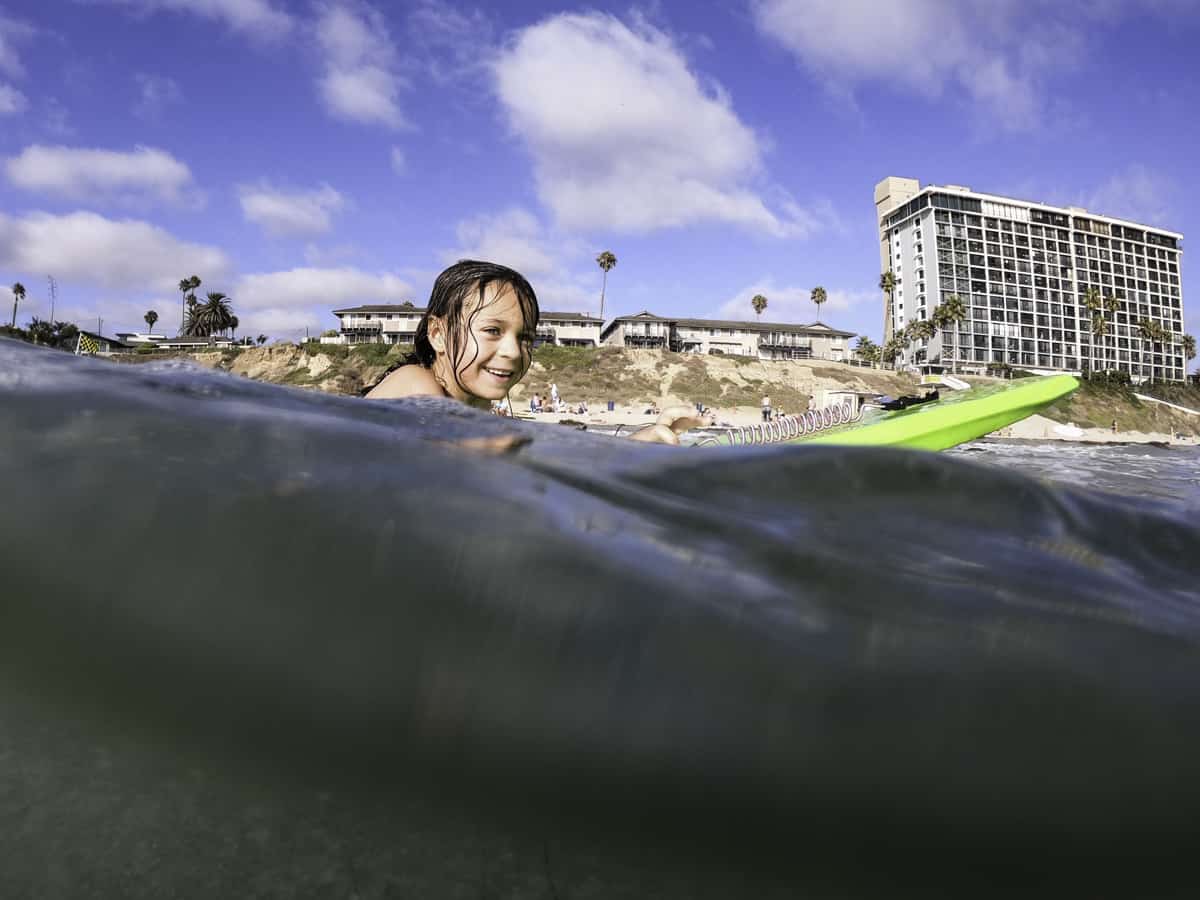
Lifeguards are not only there for emergencies but also to provide important water safety education. Lifeguards are ready and willing to help you. When you get to the beach, feel free to walk up to a lifeguard and ask a few questions. You might want to ask them their best beach safety tips, or anything that might be helpful for that specific beach on that day. Tides, currents, wave height, and break are all important facts that the lifeguard will know. Sometimes they will also have a whiteboard listing the water temperature, tide times, and the sunrise/sunset.
Ultimately, setting up near a lifeguard tower provides parents with peace of mind. Knowing that trained professionals are nearby, ready to respond in case of an emergency, alleviates anxiety and allows parents to relax and enjoy their time at the beach with their children. It adds an extra layer of safety and reassurance, making the beach experience more enjoyable for everyone.
Water safety for non-swimmers
If you are at the beach with little kids who can’t yet swim or aren’t strong swimmers, ensuring their safety becomes a top priority. Always keep a close eye on children who can’t swim or are weak swimmers. Stay close to them at all times, especially when they are in or near the water. This way, you can quickly provide assistance if needed. Opt for beaches with shallow water and gentle waves, as these areas are more suitable.
And have your child wear a properly fitted U.S. Coast Guard-approved life jacket or personal flotation device (PFD) when near or in the water. Ensure the device is appropriate for your child’s size and weight. Remember, inflatable toys or water wings are not substitutes for a life jacket and should not be relied upon for safety.
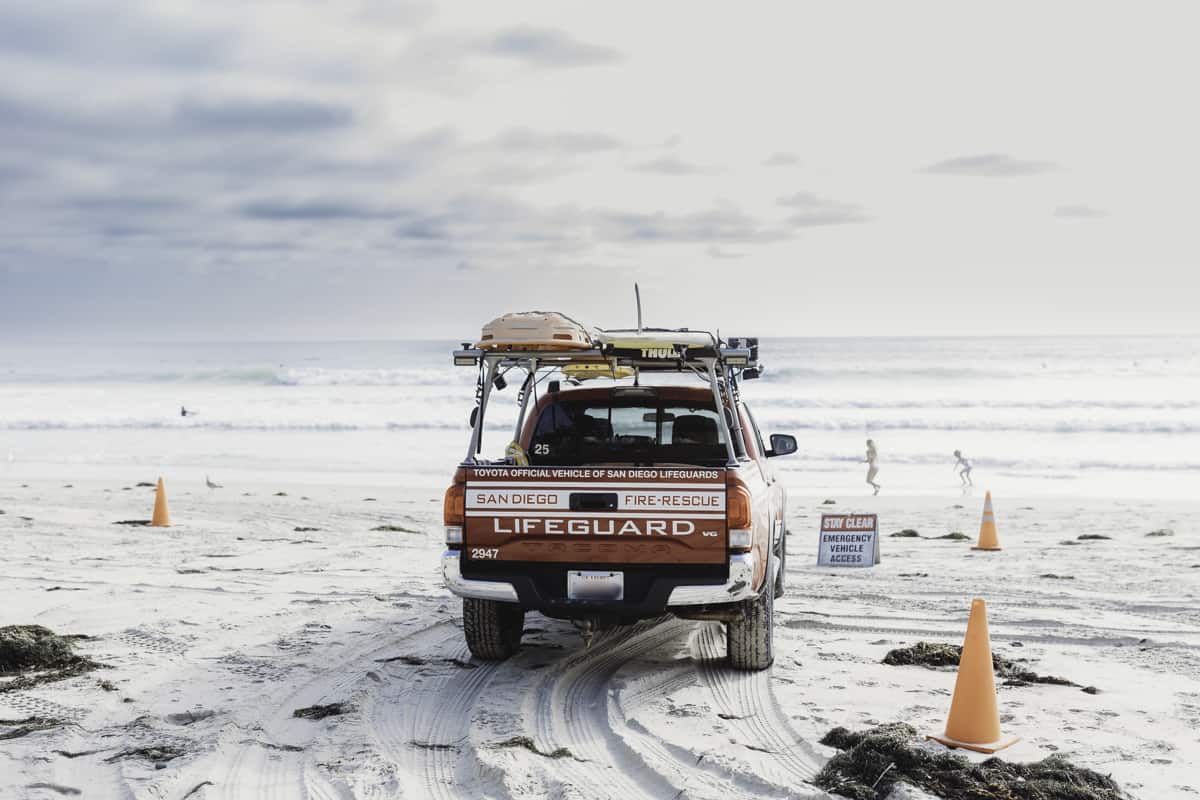
Watch the waves
The entirety of my childhood existed within an hour of the Pacific Ocean. One of the phrases I heard so many times was, “Never turn your back on the ocean.” My mom told me this to emphasize the importance of watching and paying attention to the waves. By encouraging children to watch the waves, parents instill a sense of respect for the ocean’s power and unpredictable nature. Understanding the force of waves fosters a healthy appreciation for the water and reinforces the importance of caution and responsible behavior while enjoying beach activities.
As an adult, the waves might not seem scary. But, to a child who is just a few feet off the ground, the waves can seem dangerous (and very large). Waves are a dynamic force of nature that can be powerful and unpredictable. By reminding children to watch the waves, parents help them develop a sense of wave awareness and understand their behavior. This awareness allows children to anticipate and react to waves appropriately, reducing the risk of being caught off guard or knocked over. By teaching your child to always pay attention to the waves, they will begin to feel more comfortable.
Waves have a pattern. Their rhythmic crashing can be soothing, but they are also very powerful and unpredictable. Waves can sometimes catch beachgoers, especially children, by surprise. Encouraging children to keep an eye on the waves helps them stay mindful of their surroundings and potential wave activity. This awareness enables them to adjust their position on the beach accordingly, moving to safer areas or stepping back when necessary.
With younger children, start in the water with them. Jump over the waves together. Being in the water with them will show them how fun it can be and will help them feel how the water can push and pull them. Having your hand to hold will be a reassurance, and if they get knocked down, you’ll be right there to pick them up.
If you have a daring child that likes to push their limits, I recommend giving them a guideline of how far to go. You might want to start with staying at or below the knees. As their abilities increase, you can let them go in up to their waist and then beyond.
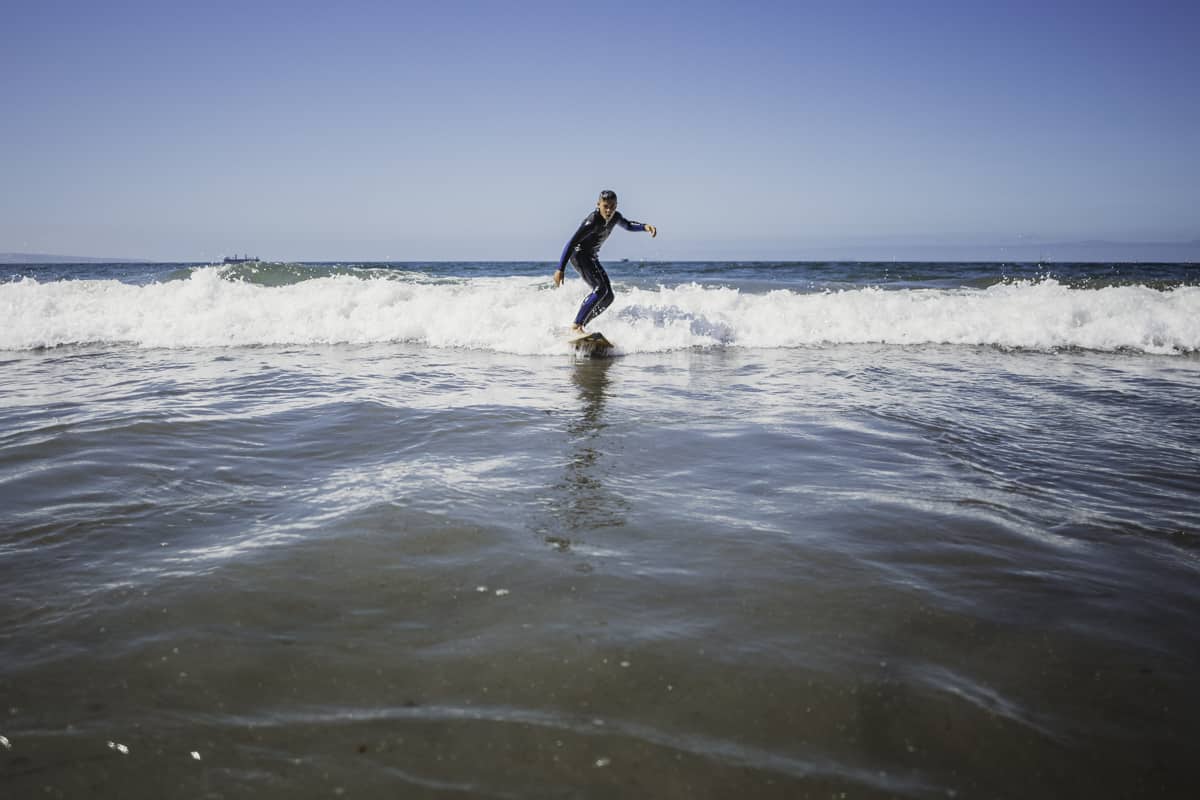
Pay attention to the flags
You might notice some flags on the beach – these are very important signals and should be paid attention to closely to ensure safety and understand the current conditions. These flags serve as visual indicators that communicate important information to beachgoers. Flags provide a standardized system for conveying information about the conditions and potential hazards/risks at the beach. They serve as a clear and easily recognizable visual language that beach visitors can understand and follow.
Now, let’s explore some commonly used beach flags and their meanings (please note that flag systems may vary between beaches and countries):
Green flag:
- A green flag typically signifies calm conditions, indicating that it’s safe to swim and enjoy the water.
- It suggests that there are no significant hazards, such as strong currents or rough surf, present at that time.
Yellow flag:
- A yellow flag indicates moderate surf conditions and potential hazards.
- It advises caution to swimmers, as there may be mild to moderate currents or waves that require increased awareness and swimming ability.
Red flag:
- A red flag represents hazardous conditions, such as strong currents, large waves, or rough surf.
- It serves as a warning that swimming in the water is not recommended. Non-swimmers and inexperienced swimmers should avoid entering the water altogether.
Purple Flag:
- A purple flag is used to warn beachgoers of the presence of potentially dangerous marine life.
- It suggests that there may be jellyfish, sharks, or other marine creatures in the area, requiring increased vigilance and caution.
Checkered flag:
- A checkered flag usually indicates that the area is designated for water sports, such as surfing or kayaking, and is not intended for swimming.
- It signals that there may be specific activities (surfing only) or hazards in that particular section of the beach. When your kids are comfortable enough in the water to boogie board, skim board, swim, or surf, they will need to pay attention to the checkered flag. They will definitely not want to get in the way of the surfers! The checkered flags will show you how to stay safe by keeping you in the right area.
Familiarize yourself with the specific flag system used at the beach you’re visiting and pay attention to any accompanying signage or instructions provided by lifeguards. By being attentive to the flags at the beach, you can stay informed about the current conditions and potential hazards, allowing you to make informed decisions about entering the water and ensuring the safety of yourself and your family.
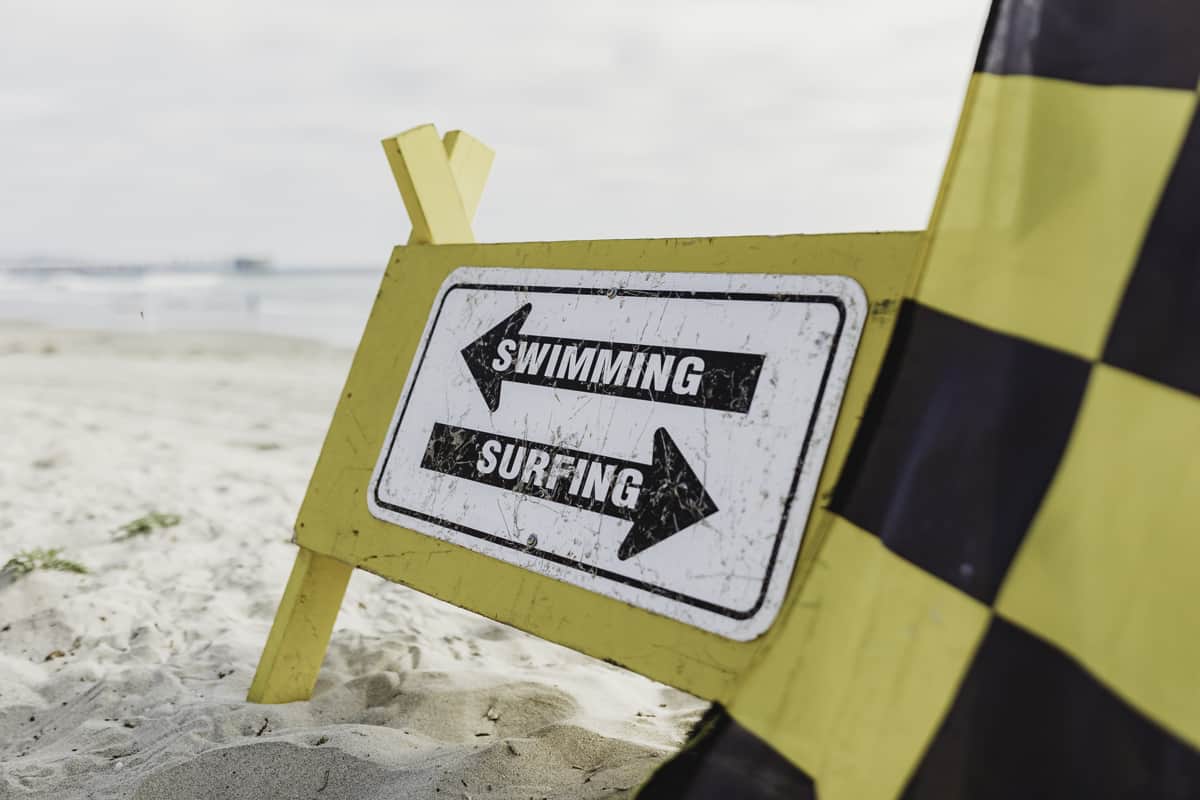

Learn the stingray shuffle
Part of what I love about the ocean is that it’s full of life. There are sand crabs to dig for, fish swimming around, floating kelp forests, and seaweed washing onto the shore. I’ve even seen pods of dolphins jumping out of the water at some of our San Diego beaches and seals and sea lions sunbathing on the sand. Most of the time, the sea life is harmless, but one you’ll want to beware of is the stingray.
Stingrays are commonly found in coastal areas with sandy bottoms. They typically bury themselves in the sand, making them difficult to spot. Accidentally stepping on a stingray can result in a painful sting from their barbed tail. Stingrays are usually docile creatures and sting as a defense mechanism when they feel threatened.
I’ve spent a lot of time in the ocean and have never encountered a stingray, but I do know people who have been stung. The treatment is to submerge the sting in hot water, which lifeguards can provide. The “stingray shuffle” is a technique used to prevent accidental encounters with stingrays, particularly in shallow coastal waters. It involves shuffling your feet along the sandy bottom instead of taking regular steps. The vibrations and movement created by the shuffle alert the stingrays to your presence, allowing them to swim away before contact is made.
That’s all there is to the stingray shuffle! This one beach safety tip can save you a lot of unnecessary pain.
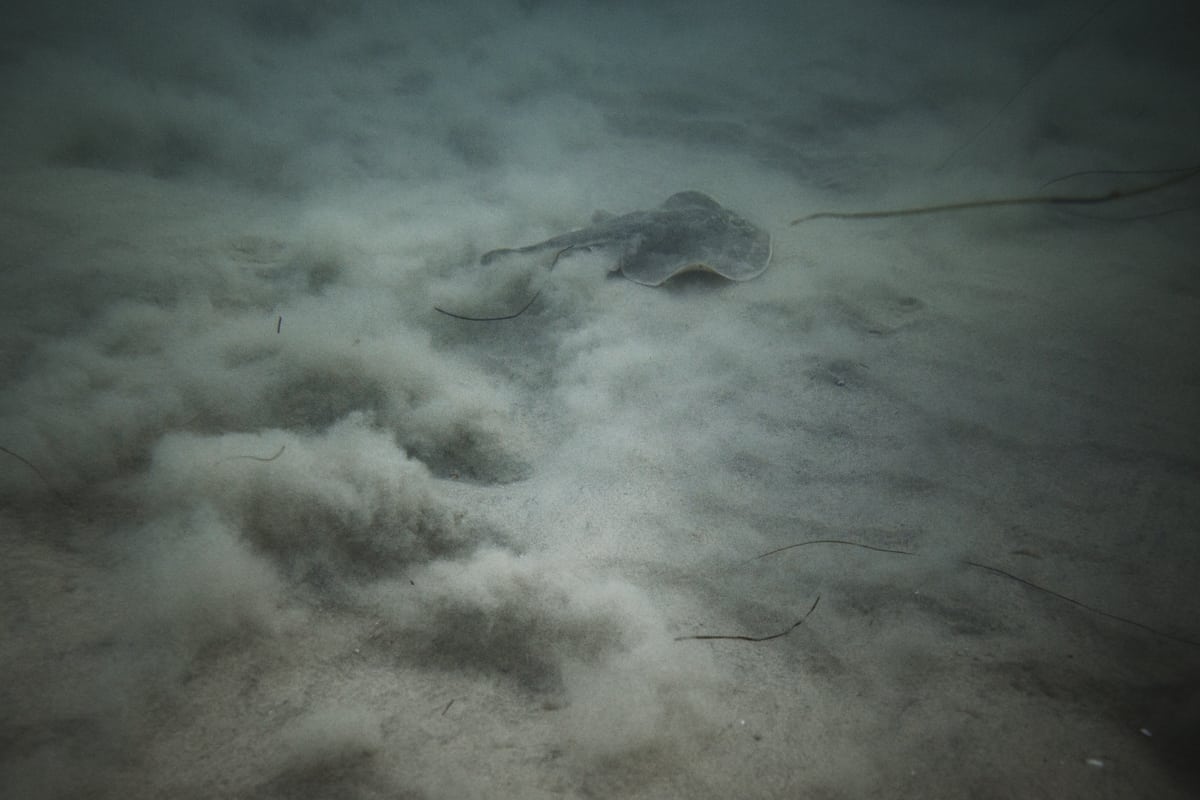
Raise your hand
When you’re out in the ocean past where the waves are breaking, maybe waiting for the perfect wave to catch with your boogie board, know that you’re still visible to the lifeguards. If you notice yourself starting to get pulled by a rip current, or you just feel like you aren’t able to get back to shore, simply raise your hand. Raising your hand is a universal distress signal that alerts people on the beach, including lifeguards and other beachgoers, that you are in trouble and need assistance. By raising your hand, you attract attention and increase the likelihood of someone noticing your predicament.
Get your hand as high above your head as you can get it, and wave until you see the lifeguard coming to help. Staying calm is key. By raising your hand, you conserve energy and avoid unnecessary swimming against the current, which can lead to fatigue and potentially worsen the situation. Instead, focus on staying afloat and signaling for help.
Here is a video about how to avoid a rip current and how to successfully exit a rip current.
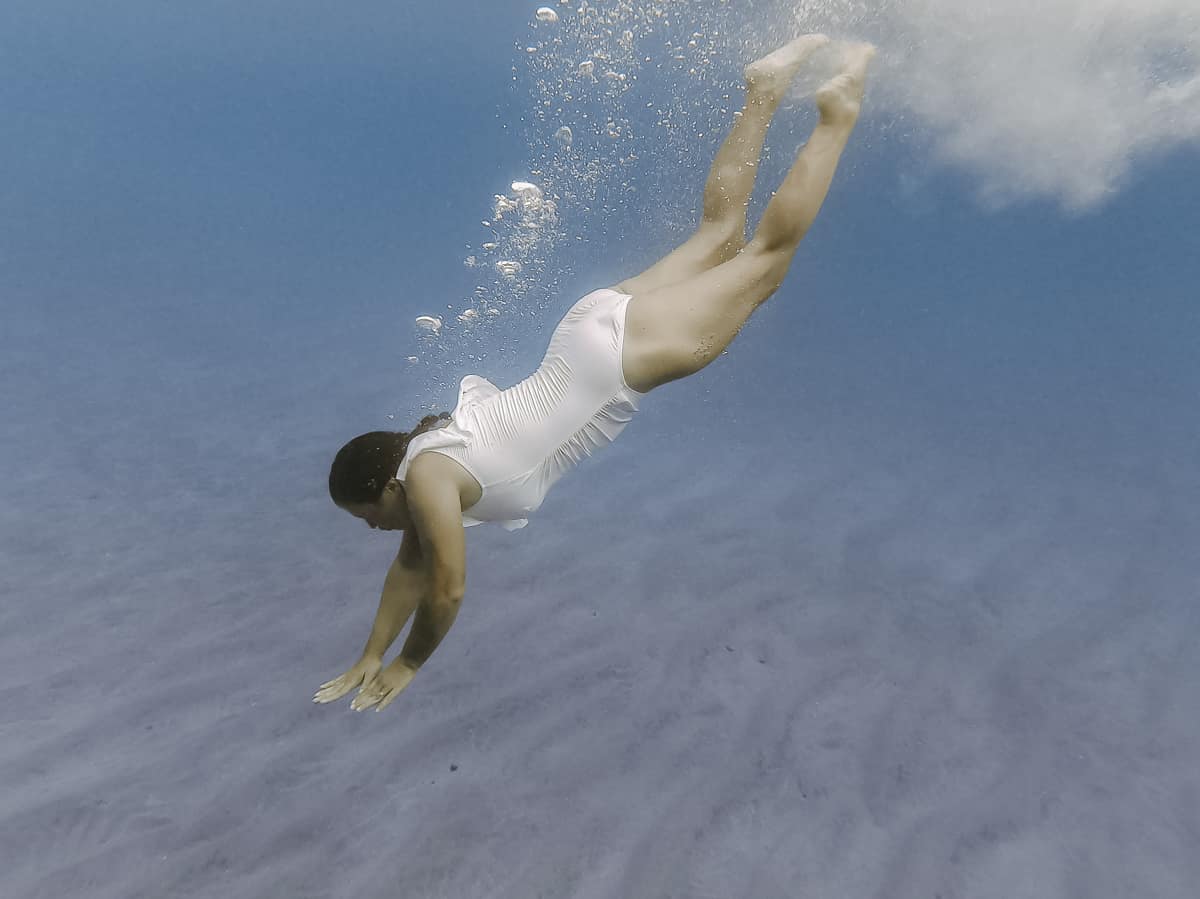
Respect the ocean, but have fun!
The ocean is my happy place. Swimming in the ocean makes me feel so incredibly free. While there are precautions that must be taken, spending time at the beach is extremely enjoyable. If you’re at the beach with other adults, I encourage you to ask them to take over, keeping an eye on the kids for a while, and alternate so you can take some time to get in the water yourself. Get your hair wet! Submerge yourself in the ocean, and just enjoy it! Feel the water ebb and flow. Bring a boogie board (more on boogie boarding with kids here) and catch a few waves. Riding on the power of the ocean is an unforgettable experience.
When your children see you enjoying the ocean, it will make them more likely to do the same. Teach them to respect the ocean and its powerful waves and tides by respecting it and enjoying it yourself.
I wish I had the right words to describe how much I love the ocean. I can’t even pin down the exact reason why I feel so strongly about it. Maybe it’s the consistency of the tides, the strength of the waves, or the vastness of the waters. I’m not really sure, but I do know how I feel when I walk out of the ocean after a swim. I would describe it as walking on the clouds. I believe that the ocean is not to be feared but respected.
As you follow these beach safety tips, you will find what a beautiful experience going to the beach can be. I hope you make some wonderful memories with your children at the beach this summer and throughout your lives.
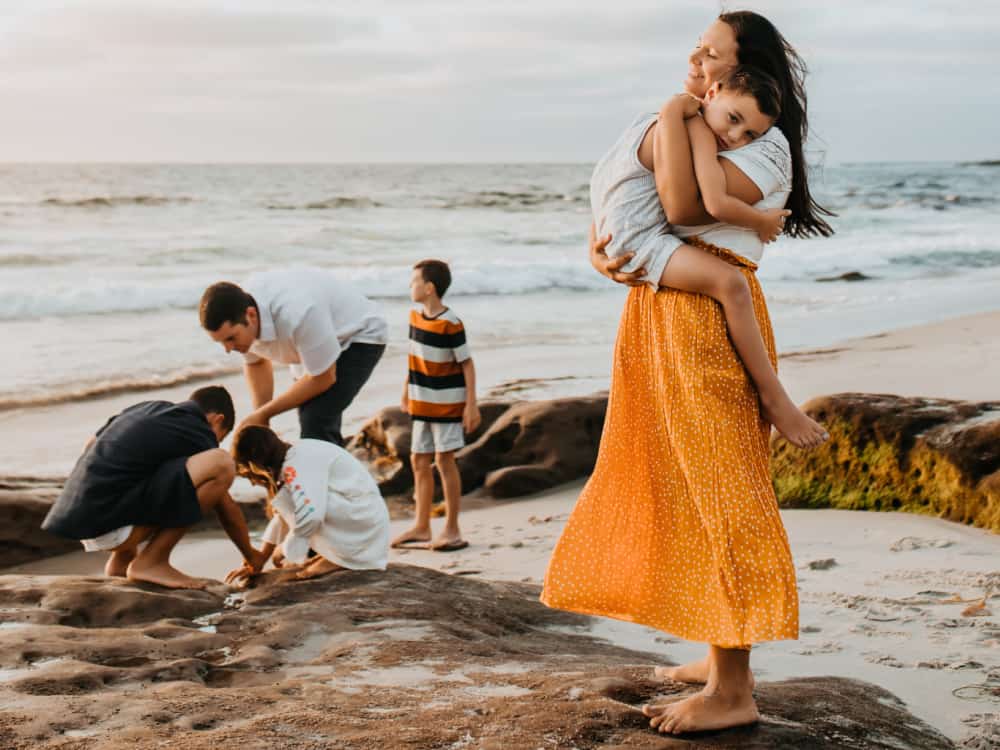
About the author
Wendy is a married momma living in central San Diego, CA, raising 4 human kids, 2 goat kids, 4 chickens, and one grumpy cat. She enjoys gardening, hiking, camping, backpacking, going to the beach, and generally getting out-of-doors. Wendy is a family photographer and also works at several local elementary schools as the garden educator. She dreams of traveling to all 50 states and beyond, and believes that there is great beauty to be found in all parts of the earth, we just have to open our eyes to see it.
You can find more from Wendy online in the following locations:
Instagram: @wendycoxphotography
RWMC posts: Wendy Cox
The post Beach Safety Tips for Parents appeared first on RUN WILD MY CHILD.

